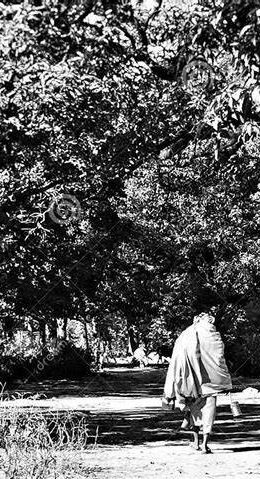The Vānaprastha Adventure, Installment 3

Śrīla Prabhupāda usually spoke of the vānaprastha āśrama as “retired life.” It is that stage of life in which we progressively detach ourselves from home and family, from “me” and “mine,” from the attachments and illusions that go with family life.
As Śrīla Prabhupāda explains, the word vana means “forest,” and prastha means “having gone.”1 In former days, people would literally retire to the forest, there to free themselves from worldly life and get ready for the final journey back to Godhead.
Today we no longer expect to go dwell in the forest and live on roots and berries. But we can still adopt the spirit and core principles of the vānaprastha āśrama, with the same purpose: to get free from material entanglements and get ready for that final journey.
To be clear: To enter the vānaprastha āśrama, we adopt a certain spirit, a certain mood, a change of heart, a change of direction. But there is more: Along with the change of heart come changes in what we do, how we live. Just as a gṛhastha lives differently than a brahmacārī, a vānaprastha lives differently than a gṛhastha. We’ll talk more about that as we ‒move along in this book.
Generally, by the way, a brahmācarī does not enter the vānaprastha āśrama. He has no need to. The vānaprastha āśrama is meant as a next step for householders, to help them get free from family attachments. But a brahmacārī has no family attachments to get free from. So a mature brahmacārī may either stay a brahmacārī for the rest of his life or accept sannyāsa.2
Notes:
1 Śrīmad-Bhāgavatam class, July 8, 1975, Chicago. The vānaprastha āśrama is also sometimes called the vaikhānasa āśrama (Bhāgavatam 4.23.4 and purport), although at other times the word vaikhānasa is used to refer to one of four divisions of vānaprastha life (Bhāgavatam 3.12.43, Cc. Ādi 7.34, purport).
2 Śrīla Prabhupāda writes, “[O]ne may proceed to the sannyāsa-āśrama directly from the brahmacārī-āśrama.” He cites the example of Śrīla Bhaktisiddhānta Sarasvatī Ṭhākura, who did precisely that (Bhāgavatam 7.12.13‒14, purport). The Jābālopaniṣad (4.1) says that one may go from brahmacārya to gṛhastha to vānaprastha to sannyāsa or alternatively may accept sannyāsa directly from life as a brahmacārī, gṛhastha, or vānaprastha (yadi vetarathā brahmacaryād eva pravrajed gṛhād vā vanād vā).
Commenting on the last line of Bhāgavatam 7.12.14 (gṛhaṁ vanaṁ vā praviśet pravrajet tatra vā vaset), Śrīla Prabhupāda says (as does the verse) that from the brahmacārī-āśrama one may accept the sannyāsa-āśrama, vānaprastha-āśrama or gṛhastha-āśrama. But neither in this purport nor elsewhere does he say anything further about a brahmacārī’s becoming a vānaprastha. Commenting on the same verse, Śrīla Viśvanātha Cakravartī Ṭhākura says that a brahmacārī may either enter household life or stay on as a naisthika-brahmacārī.
This is part of a draft
This is an excerpt from a new book I have in the works—The Vanaprastha Adventure, a guide to retirement in spiritual life. While I’m working on it, I’ll be posting my draft here, in installments. I invite your comments, questions, and suggestions.

Hare Krishna Maharaja,
This is a great and very relevant topic you are writing a book on. With the rampant Kaliyuga progressing and wrath of corporate world, there is actually no security, infrastructure, role models for devotees who are ready to enter vanaprastha.
It will be great if you can mention some more case studies of devotees who successfully entered vanaprastha and made advancement towards Krishna.
Also, it would be great to hear from you what you think about the importance of varnasrama (farm communities and cow protection) and how devotees can preserve it.
I hope this message finds you in good spirits and good health.
I will be very interested in your new book and your findings. When do you anticipate it being finished?
You may not be aware, but I am in my second marriage, which is now 25 years in the making. At age 72 I have two grown-up sons from my previous marriage and a 16-year-old son from this marriage. My wife and I have abstained from sexual activity since our son was conceived.
From an age point of view, I would normally be preparing for the Sannyasa order. However, having a young son who is on the “Spectrum” and me with a failing transplanted kidney and several other major health issues, the goal of Sannyasa looks bleak. My wife has taken good care of me between hospital stays and in fact, was the donor for my transplanted kidney four years ago. I consider myself a Vanaprastha (with a renunciate mindset), with the exception of having to live a family life due to health issues. So, I will be interested in how my fallen situation is viewed by your good self. It certainly is not a normal situation. But, having experienced several near-death events in the last few years and the blessing of Srila Prabhupada, real detachment from this material drama has become quite the norm for me.
Your servant and friend,
Krishna Gopal das